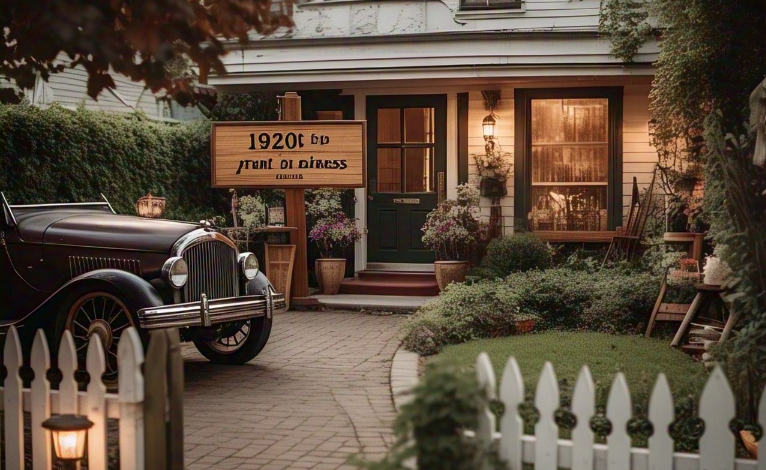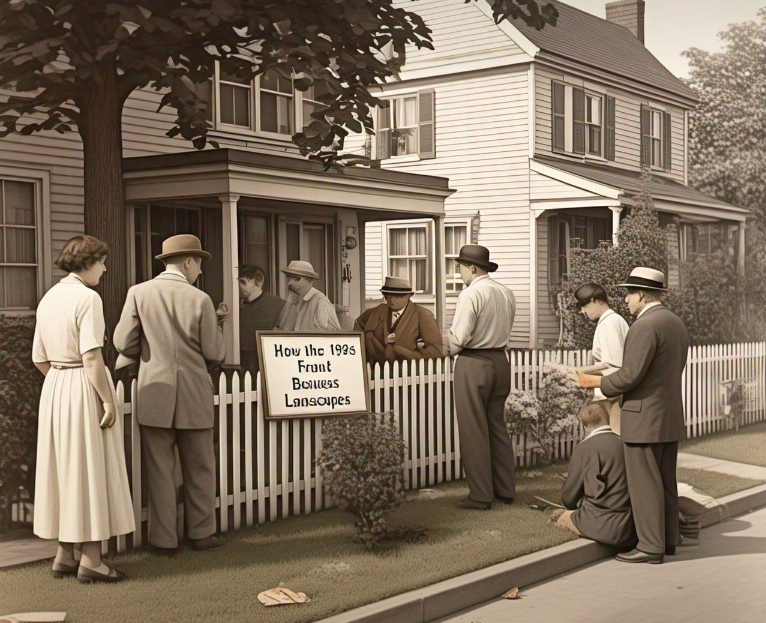How the 1920s Front Yard Business Shaped Modern Landscapes

The 1920s front yard business was all about creating beautiful outdoor spaces that made homes stand out. Back then, people began paying more attention to their front yards as a way to showcase their homes. Landscaping became an important part of how people expressed their style, and the front yard business grew. The idea of having a well-maintained front yard was not just about decoration; it was also about showing off wealth and status.
In the 1920s, a front yard wasn’t just a patch of grass; it was a carefully designed space with flowers, bushes, and pathways. The 1920s front yard business helped shape the way we see landscaping today. Many of the trends from that time still influence how we design and maintain our front yards now. From the use of greenery to the layout of outdoor spaces, the 1920s set the stage for modern landscaping techniques.
Table of Contents
How the 1920s Front Yard Business Shaped Modern Landscapes

The 1920s front yard business marked a turning point in how we view outdoor spaces. Back then, people realized that a well-designed front yard could speak volumes about the homeowner. It wasn’t just about having a patch of grass outside—it was about showing off the home’s style and personality. This new focus on landscaping made front yards an essential part of suburban life, and it quickly became a business for many landscapers.
The idea of beautifying the front yard spread quickly in the 1920s. Wealthier families were eager to have a perfect outdoor space that was visible to everyone passing by. The use of flowering plants, neatly trimmed hedges, and perfectly manicured lawns became symbols of prosperity and good taste. This shift in how people viewed their front yards helped create the landscaping industry that we know today.
What Made the 1920s Front Yard Business So Popular
In the 1920s, front yards were more than just green spaces—they were a statement. The demand for beautiful yards grew as people saw the opportunity to make their homes stand out in a growing suburban landscape. With the rise of the middle class and the availability of new landscaping tools, more people could afford to improve their front yards. Landscaping businesses began to thrive, catering to homeowners who wanted to show off their wealth and style.
Many families hired landscapers to design and maintain their front yards. The focus was on using plants and features that would add to the beauty and charm of the home. The front yard business in the 1920s grew because it appealed to homeowners who wanted to make a statement about their success. These yards became a reflection of the homeowner’s status and taste, and it quickly became a trend that lasted for many decades.
How the 1920s Front Yard Business Created Lasting Landscaping Trends
The 1920s front yard business set the foundation for modern landscaping. Many of the design principles used in that time are still popular today. Back then, homeowners focused on symmetry, with balanced flower beds, neatly trimmed bushes, and evenly spaced trees. The idea was to create a front yard that was both beautiful and orderly, giving the home a welcoming and polished look.
Even today, we still see these ideas in front yards across the country. Neatly manicured lawns, trimmed hedges, and colorful flower beds continue to be popular choices for homeowners. The 1920s front yard business introduced the concept of “curb appeal,” which is still a key part of landscaping today. People understood that a beautiful front yard could increase the value of their home and make a lasting impression.
Top 1920s Front Yard Features That Are Still Used Today

Many features from the 1920s front yard business remain timeless. One of the most popular elements from that era is the garden path. These paths were often made of stone or brick and led visitors from the sidewalk to the front door. The idea was to create an inviting entrance, making the yard feel like an extension of the home.
Another feature that became popular in the 1920s was the use of ornamental plants and shrubs. Families would often plant colorful flowers and shrubs in carefully arranged patterns to add visual interest. These plants weren’t just chosen for their beauty—they were selected to reflect the homeowner’s personality and style. Even today, people use flowers and plants to make their front yards stand out.
The Influence of 1920s Front Yard Business on Modern Landscaping Designs
The influence of the 1920s front yard business can still be seen in modern landscaping designs. Back then, people started treating their yards like outdoor living rooms, creating spaces where they could entertain guests and showcase their style. Today, many homeowners continue this tradition by designing their yards to be both functional and attractive. Outdoor kitchens, seating areas, and decorative features are now common in front yards, just like they were in the 1920s.
The emphasis on beauty and orderliness from the 1920s still influences how we design our front yards. People want their yards to be neat and welcoming, with a focus on curb appeal. This influence is evident in everything from plant choices to the layout of the yard. Even as modern landscaping technologies and designs evolve, the core principles of the 1920s front yard business remain important.
Creating a Modern Front Yard with 1920s-Inspired Landscaping Ideas
If you’re looking to design a front yard with a nod to the past, the 1920s front yard business offers some great inspiration. Start with symmetry—balanced flower beds, evenly spaced trees, and neatly trimmed shrubs can create a classic, timeless look. Incorporate elements like garden paths and ornamental plants, which were popular in the 1920s, to add charm and character to your yard.
Don’t forget to make your front yard an inviting space. As the 1920s front yard business showed, your front yard should be an extension of your home. Whether you’re hosting guests or simply enjoying the outdoors, a well-designed front yard can offer both beauty and functionality. The principles from the 1920s are still relevant today, helping homeowners create beautiful, welcoming outdoor spaces.
By following the trends of the 1920s front yard business, you can design a front yard that not only looks great but also reflects your style. With a mix of historical influence and modern design, your front yard can be the perfect blend of old and new.
Incorporating 1920s Front Yard Ideas in Modern Landscaping

The 1920s front yard business left a lasting impression on the way we design and use our outdoor spaces today. If you’re thinking about updating your front yard, there are several easy and effective ways to bring some of those classic 1920s ideas into your modern landscaping. Here’s how you can do it!
One of the key elements from the 1920s is the use of symmetry and balance. In the 1920s, a well-balanced front yard was considered a symbol of order and elegance. You can recreate this by planting flowers and shrubs in even numbers or organizing them in matching patterns on each side of a garden path. For example, place identical plants or statues on either side of your front door to make your yard feel balanced and neat.
Another feature that made the 1920s front yards so appealing was the addition of garden paths. These paths helped connect different areas of the yard and made it easier to walk through the space. Today, you can still use garden paths made from materials like stone, bricks, or gravel to give your front yard a vintage, charming look. These paths can lead to your front door, around your garden beds, or even to a cozy seating area in the yard.
Decorative elements were also an important part of 1920s front yard design. Think about adding small garden statues, birdbaths, or even a small fountain to your front yard. These features not only add a sense of style but also draw attention to key areas of your yard. Just like in the 1920s, adding a few special items can make your front yard stand out and feel unique.
By using some of these ideas, you can create a beautiful front yard that has a classic 1920s look while still fitting into modern landscaping trends. Simple updates like adding symmetry, paths, and decorative elements can bring your front yard to life and make it a welcoming space for everyone who visits your home.
Conclusion
The 1920s front yard business really changed how we look at our outdoor spaces. It taught us that a front yard is not just a place for grass and trees—it’s a chance to show off our style and personality. Many of the ideas from that time are still used today, helping people create beautiful yards that make a good impression. If you want to make your front yard stand out, taking inspiration from the 1920s can be a great place to start!
Even though things have changed over the years, the basics of the 1920s front yard business are still important. A neat, balanced yard with flowers, plants, and paths can make your home look inviting and special. So, next time you’re thinking about redesigning your front yard, remember the lessons from the 1920s—it’s all about beauty, order, and making your home look its best.
FAQs
Q: What was the main idea behind the 1920s front yard business?
A: The main idea was to create beautiful, neat, and organized front yards that showed off the homeowner’s style and wealth.
Q: Are 1920s front yard designs still popular today?
A: Yes, many elements from the 1920s, like garden paths, symmetrical designs, and ornamental plants, are still used in modern front yards.
Q: What features made 1920s front yards stand out?
A: 1920s front yards were known for their carefully planned flower beds, neat lawns, and decorative elements like garden paths and ornamental shrubs.
Q: How can I create a 1920s-inspired front yard today?
A: To create a 1920s-inspired yard, focus on symmetry, use plants that reflect your style, and add features like a garden path or ornamental flowers.
Q: Did the 1920s front yard business impact modern landscaping?
A: Yes, the 1920s front yard business introduced the idea of curb appeal and helped shape modern landscaping designs with its focus on beauty and order.




